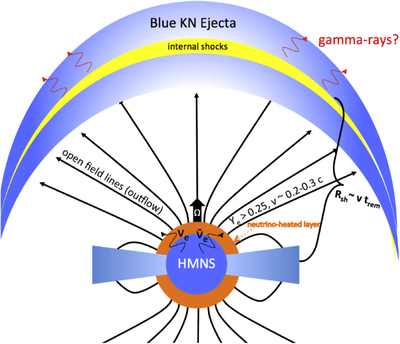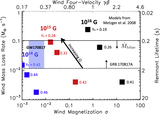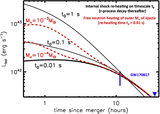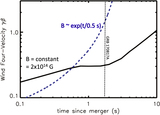Image Details

Caption: Figure 1.
Schematic diagram of the neutrino-irradiated wind from a magnetized HMNS. Neutrinos from the HMNS heat matter in a narrow layer above the HMNS surface, feeding baryons onto open magnetic field lines at a rate that is substantially enhanced by magnetocentrifugal forces from the purely neutrino-driven mass-loss rate (e.g., Thompson et al. 2004; Metzger et al. 2007). Magnetic forces also accelerate the wind to a higher asymptotic velocity v ≈ vB ≈ 0.2–0.3 c (Equation (5)) than the purely neutrino-driven case v ≲ 0.1 c (Equation (2)), consistent with the blue KN ejecta. Though blocked by the accretion disk directly in the equatorial plane, the outflow has its highest rate of mass-loss rate, kinetic energy flux, and velocity at low latitudes near the last closed field lines (Vlasov et al. 2014). The wind velocity ∝σ1/3 ∝ B2/3/﹩\dot{M}﹩1/3 may increase by a factor of ∼2 over the HMNS lifetime (Figure 4) as its mass-loss rate ﹩\dot{M}﹩ subsides, or its magnetic field B is amplified, resulting in internal shocks on a radial scale ﹩{R}_{\mathrm{sh}}\sim {{vt}}_{\mathrm{rem}}\sim {10}^{10}({t}_{\mathrm{rem}}/1{\rm{s}})﹩ cm, substantially larger than the wind launching point. This late re-heating of the ejecta leads to brighter KN emission within the first few hours after the merger (Figure 3). Relativistic breakout of the shocks as the magnetar wind becomes transrelativistic on a similar timescale might also give rise to gamma-ray emission.
Copyright and Terms & Conditions
© 2018. The American Astronomical Society. All rights reserved.






